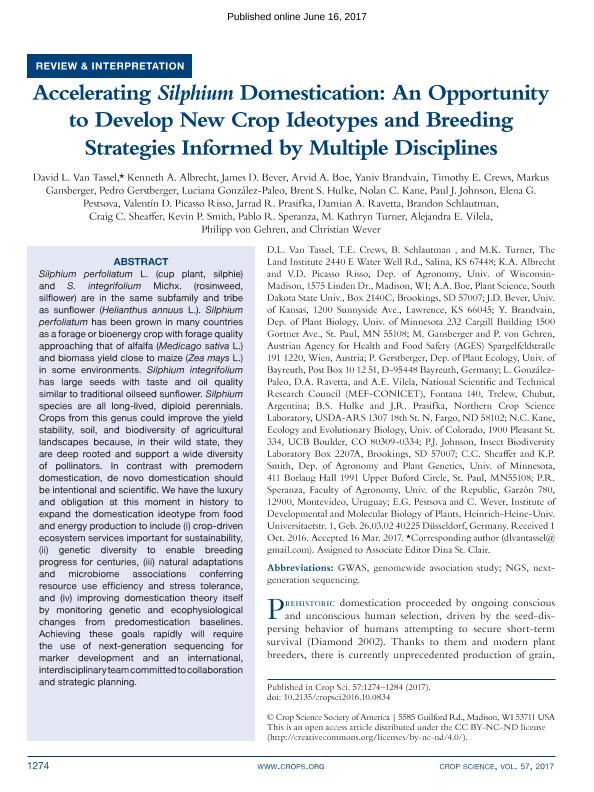Artículo
Accelerating silphium domestication: An opportunity to develop new crop ideotypes and breeding strategies informed by multiple disciplines
Van Tassel, David; Albrecht, Kenneth A.; Bever, James D.; Boe, Arvid A.; Brandvain, Yaniv; Crews, Timothy E.; Gansberger, Markus; Gerstberger, Pedro; González Paleo, Luciana ; Hulke, Brent S.; Kane, Nolan C.; Johnson, Paul J.; Pestsova, Elena G.; Picasso Risso, Valentín D.; Prasifka, Jarrad R.; Ravetta, Damián Andrés
; Hulke, Brent S.; Kane, Nolan C.; Johnson, Paul J.; Pestsova, Elena G.; Picasso Risso, Valentín D.; Prasifka, Jarrad R.; Ravetta, Damián Andrés ; Schlautman, Brandon; Sheaffer, Craig C.; Smith, Kevin P.; Speranza, Pablo R.
; Schlautman, Brandon; Sheaffer, Craig C.; Smith, Kevin P.; Speranza, Pablo R.
 ; Hulke, Brent S.; Kane, Nolan C.; Johnson, Paul J.; Pestsova, Elena G.; Picasso Risso, Valentín D.; Prasifka, Jarrad R.; Ravetta, Damián Andrés
; Hulke, Brent S.; Kane, Nolan C.; Johnson, Paul J.; Pestsova, Elena G.; Picasso Risso, Valentín D.; Prasifka, Jarrad R.; Ravetta, Damián Andrés ; Schlautman, Brandon; Sheaffer, Craig C.; Smith, Kevin P.; Speranza, Pablo R.
; Schlautman, Brandon; Sheaffer, Craig C.; Smith, Kevin P.; Speranza, Pablo R.
Fecha de publicación:
06/2017
Editorial:
Crop Science Society of America
Revista:
Crop Science
ISSN:
0011-183X
Idioma:
Inglés
Tipo de recurso:
Artículo publicado
Clasificación temática:
Resumen
Silphium perfoliatum L. (cup plant, silphie) and S. integrifolium Michx. (rosinweed, silflower) are in the same subfamily and tribe as sunflower (Helianthus annuus L.). Silphium perfoliatum has been grown in many countries as a forage or bioenergy crop with forage quality approaching that of alfalfa (Medicago sativa L.) and biomass yield close to maize (Zea mays L.) in some environments. Silphium integrifolium has large seeds with taste and oil quality similar to traditional oilseed sunflower. Silphium species are all long-lived, diploid perennials. Crops from this genus could improve the yield stability, soil, and biodiversity of agricultural landscapes because, in their wild state, they are deep rooted and support a wide diversity of pollinators. In contrast with premodern domestication, de novo domestication should be intentional and scientific. We have the luxury and obligation at this moment in history to expand the domestication ideotype from food and energy production to include (i) crop-driven ecosystem services important for sustainability, (ii) genetic diversity to enable breeding progress for centuries, (iii) natural adaptations and microbiome associations conferring resource use efficiency and stress tolerance, and (iv) improving domestication theory itself by monitoring genetic and ecophysiological changes from predomestication baselines. Achieving these goals rapidly will require the use of next-generation sequencing for marker development and an international, interdisciplinary team committed to collaboration and strategic planning.
Palabras clave:
New Crops
,
Perennials
,
Domestication
,
Ideotype
Archivos asociados
Licencia
Identificadores
Colecciones
Articulos(SEDE CENTRAL)
Articulos de SEDE CENTRAL
Articulos de SEDE CENTRAL
Citación
Van Tassel, David; Albrecht, Kenneth A.; Bever, James D.; Boe, Arvid A.; Brandvain, Yaniv; et al.; Accelerating silphium domestication: An opportunity to develop new crop ideotypes and breeding strategies informed by multiple disciplines; Crop Science Society of America; Crop Science; 57; 3; 6-2017; 1274-1284
Compartir
Altmétricas



